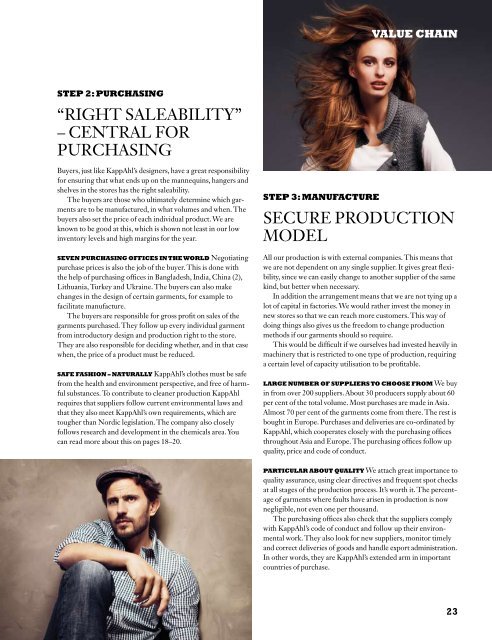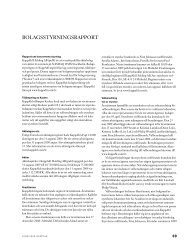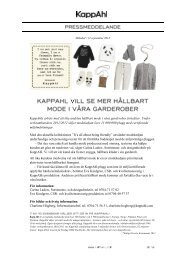We - KappAhl
We - KappAhl
We - KappAhl
You also want an ePaper? Increase the reach of your titles
YUMPU automatically turns print PDFs into web optimized ePapers that Google loves.
STEP 2: PURCHASING<br />
“RIGHT SALEABILITY”<br />
– CENTRAL FOR<br />
PURCHASING<br />
Buyers, just like <strong>KappAhl</strong>’s designers, have a great responsibility<br />
for ensuring that what ends up on the mannequins, hangers and<br />
shelves in the stores has the right saleability.<br />
The buyers are those who ultimately determine which garments<br />
are to be manufactured, in what volumes and when. The<br />
buyers also set the price of each individual product. <strong>We</strong> are<br />
known to be good at this, which is shown not least in our low<br />
inventory levels and high margins for the year.<br />
SEVEN PURCHASING OFFICES IN THE WORLD Negotiating<br />
purchase prices is also the job of the buyer. This is done with<br />
the help of purchasing offices in Bangladesh, India, China (2),<br />
Lithuania, Turkey and Ukraine. The buyers can also make<br />
changes in the design of certain garments, for example to<br />
facilitate manufacture.<br />
The buyers are responsible for gross profit on sales of the<br />
garments purchased. They follow up every individual garment<br />
from introductory design and production right to the store.<br />
They are also responsible for deciding whether, and in that case<br />
when, the price of a product must be reduced.<br />
SAFE FASHION – NATURALLY <strong>KappAhl</strong>’s clothes must be safe<br />
from the health and environment perspective, and free of harmful<br />
substances. To contribute to cleaner production <strong>KappAhl</strong><br />
requires that suppliers follow current environmental laws and<br />
that they also meet <strong>KappAhl</strong>’s own requirements, which are<br />
tougher than Nordic legislation. The company also closely<br />
follows research and development in the chemicals area. You<br />
can read more about this on pages 18–20.<br />
STEP 3: MANUFACTURE<br />
VALUE CHAIN<br />
SECURE PRODUCTION<br />
MODEL<br />
All our production is with external companies. This means that<br />
we are not dependent on any single supplier. It gives great flexibility,<br />
since we can easily change to another supplier of the same<br />
kind, but better when necessary.<br />
In addition the arrangement means that we are not tying up a<br />
lot of capital in factories. <strong>We</strong> would rather invest the money in<br />
new stores so that we can reach more customers. This way of<br />
doing things also gives us the freedom to change production<br />
methods if our garments should so require.<br />
This would be difficult if we ourselves had invested heavily in<br />
machinery that is restricted to one type of production, requiring<br />
a certain level of capacity utilisation to be profitable.<br />
LARGE NUMBER OF SUPPLIERS TO CHOOSE FROM <strong>We</strong> buy<br />
in from over 200 suppliers. About 30 producers supply about 60<br />
per cent of the total volume. Most purchases are made in Asia.<br />
Almost 70 per cent of the garments come from there. The rest is<br />
bought in Europe. Purchases and deliveries are co-ordinated by<br />
<strong>KappAhl</strong>, which cooperates closely with the purchasing offices<br />
throughout Asia and Europe. The purchasing offices follow up<br />
quality, price and code of conduct.<br />
PARTICULAR ABOUT QUALITY <strong>We</strong> attach great importance to<br />
quality assurance, using clear directives and frequent spot checks<br />
at all stages of the production process. It’s worth it. The percentage<br />
of garments where faults have arisen in production is now<br />
negligible, not even one per thousand.<br />
The purchasing offices also check that the suppliers comply<br />
with <strong>KappAhl</strong>’s code of conduct and follow up their environmental<br />
work. They also look for new suppliers, monitor timely<br />
and correct deliveries of goods and handle export administration.<br />
In other words, they are <strong>KappAhl</strong>’s extended arm in important<br />
countries of purchase.<br />
2008/2009 Kappahl 23





